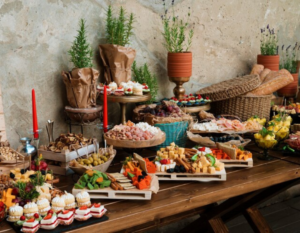 Whether you’re planning a wedding reception, a corporate marketing event, or a local fundraiser, one of the star attractions of the day will be the refreshments.
Whether you’re planning a wedding reception, a corporate marketing event, or a local fundraiser, one of the star attractions of the day will be the refreshments.
A big part of staging any successful event, and of being a good host in general, is providing an exceptional dining service for your guests.
Of course, there’s more to that than simply hiring a catering service and choosing a few select dishes from their menu. You also have to consider what type of dinner service is right for your party (not to mention your budget).
There are a number of options to consider, from cocktails and hors d’oeuvres to a proper plated dinner, and there are advantages and disadvantages to each.
So, to help you decide on the ideal serving style for your next event, we’ve put together a short guide to a few of the more popular meal options, highlighting the pros and cons of each.
Cocktail Style
Cocktail service has become something of a trend over the last few years, particularly with wedding receptions and bridal showers. Guests have the opportunity to mingle in a casual atmosphere while sampling some tasty tit-bits and sharing some fine cocktails.
Hors d’oeuvres can be passed by servers or laid out buffet style so guests can help themselves, and trained bartenders can ensure that everyone is served the drink of their choice. It’s a good fit for smaller events, especially those of a more personal and festive nature.
- Pros – Cocktail service is perfect for smaller venues, and allows guests to circulate and mingle in a relaxed atmosphere. Food costs are reduced as compared to a buffet or sit down dinner.
- Cons – While food costs can be reduced, liquor costs tend to be greater than with other service options. Guests expecting a full meal may be disappointed, so it is important to highlight cocktail service on your event invitations.
Buffet Style
Buffet style service is perhaps the most casual type of meal service, and it is a good choice for corporate events and fundraisers. Guests have the opportunity to mingle and chat as they serve themselves from a delicious array of expertly prepared dishes. Variety is the key here, and it makes it easier to satisfy everyone’s appetite.
- Pros – As your guests will be serving themselves, the need for multiple servers is reduced, cutting down on staffing costs. Multiple menu options make it easier to satisfy all of your guests, particularly those with food allergies are specific diet restrictions.
- Cons – As your guests will be serving themselves, the time required for dinner service will be longer and people will have to wait in line for their food. While your menu options will be more flexible, food costs will likely be greater as people tend to eat more when they serve themselves.
Food Stations
Food stations are another big trend in party planning, and one that brings a lot of culinary excitement to an event. Multiple mobile food stations are installed in your event space, providing your guests with an array of meal choices.
For example, you might feature a raw bar, a tapas station, a pasta station, and a carving station. Of course, you’ll also want to include a couple of choice desert stations to round out the selection. Like a buffet, your guests can mix and match from any station, creating their own dinner menu while they enjoy each other’s company.
- Pros – Food stations create fun and excitement, always a plus for any event. Meals are cooked to order, so every guest will be able to get what they want prepared the way they want it – hot and fresh. Multiple food stations help to reduce waiting time for food service.
- Cons – Multiple food stations will require a fairly large venue, with the facilities to support their operation. You will also need to hire multiple chefs to man the stations. Like a buffet, people tend to eat more with food stations, and that can increase your overall food costs.
The Plated Dinner
By far the most popular of any dinner service, regardless of the type of event, is the traditional sit down dinner service.
Typically, plated dinner service consists of three courses individually served by trained and experienced waitstaff. Guests are usually given a choice of two to three entrees, which they should select when they RSVP for the event.
Plated dinner service is formal and elegant, and suitable for most high end events, from wedding receptions to political fundraisers.
- Pros – Guests are served at the same time, allowing for better control over the time allotted for dinner service. Catering staff can more carefully plan their menus, giving them greater control over food costs.
- Cons – Plated dinner service requires more waitstaff (both in the kitchen and on the floor) which will increase your event’s labor costs. Because the menu is preset, meal options are by necessity more limited making it difficult to accommodate guests with specific dietary requests.
The style of dinner service you choose will ultimately be informed by the type of event you are staging and the atmosphere you wish to create. Of course, budgetary concerns will also figure into any final decisions, and they must be weighed accordingly.
Still, whatever the event, dining service is a key component of its success, and the style of service you choose is just as important as the menu you and your caterer create.




